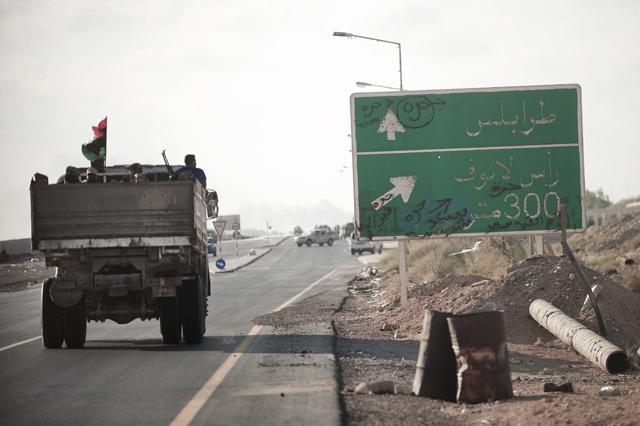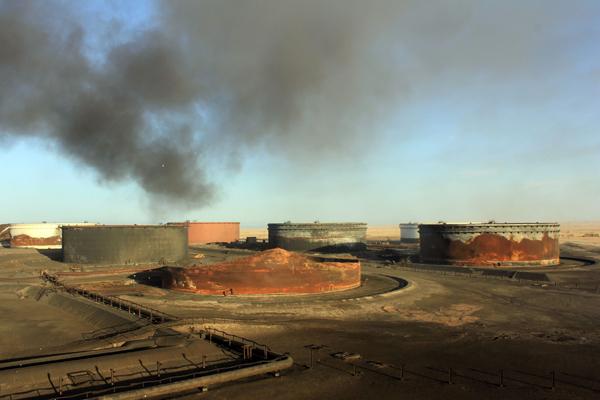You are here
East Libyan forces advance to retake oil ports
By Thomson Reuters Foundation - Jun 22,2018 - Last updated at Jun 22,2018

In this file photo taken on August 24, 2011, a supplies truck drives through the main road in the oil rich town of Ras Lanuf, some 150kms East of Sirte (AFP photo)
BENGHAZI/VIENNA — East Libyan forces said on Thursday they had retaken the shuttered oil ports of Es Sider and Ras Lanuf, hours after clashes resumed south of Ras Lanuf during a counter-attack by rival factions.
Staff were evacuated from terminals in Libya's eastern oil crescent and exports were suspended last Thursday when armed opponents of eastern-based military commander Khalifa Haftar stormed the ports and occupied them.
The closure has led to production losses of up to 450,000 barrels per day (bpd) and two oil storage tanks were destroyed or badly damaged by fires during the fighting.
For the past week, Haftar's Libyan National Army (LNA) has pounded the area with air strikes as it mobilised to retake the ports, and it continued to target its rivals with air strikes on Thursday as they retreated.
Haftar is one of the figures vying for power in Libya since the country fragmented following a NATO-backed uprising in 2011. He has received increased international recognition since seizing the oil crescent ports in 2016 and allowing the National Oil Corp. (NOC) to reopen them, despite his rejection of a UN-backed government in the capital Tripoli.
Ahmed Al Mismari, a spokesman for the LNA which Haftar built up during his three-year campaign to seize the eastern city of Benghazi, said troops had retaken Es Sider by mid-morning.
He said Ras Lanuf — which includes a residential town, an air strip, storage tanks and a refinery alongside the oil terminal — had also been taken by the LNA, as rivals had fled to the west and south into the desert, suffering heavy losses.
"The oil crescent is thanks to God under full control," Mismari said.
Hours earlier military and local sources said clashes had resumed south of Ras Lanuf when the LNA's opponents counterattacked. Medical and military sources confirmed 10 dead and 13 wounded among LNA forces.
An oil engineer said a third oil storage tank may have been hit after photos published on social media showed thick black smoke rising from the area, though officials were still trying to confirm the source of the fire.
Output cut
Libya's national production has been cut to between 600,000 and 700,000bpd from more than 1 million bpd during the oil crescent clashes, but NOC Chairman Mustafa Sanalla said he was expecting a quick restart.
Production at AGOCO, an NOC subsidiary based in the east, has fallen from around 250,000 to 180,000bpd, an oil official said on Thursday, due to power problems and to disruption at Ras Lanuf.
"Libyan production is very low but we are going to resume very soon," Sanalla told reporters in Vienna. "After a couple of days we will resume, we start our operations hopefully."
The NOC has blamed the attack on the terminals on militias led by Ibrahim Jathran, who blockaded oil crescent ports for several years before losing control of them in 2016.
The LNA has said the Benghazi Defence Brigades — a coalition of anti-Haftar fighters that previously tried to advance on Benghazi and seized Ras Lanuf and Es Sider for 10 days in March 2017 — were also involved. Both sides have drawn on mercenaries recruited from southern Libya, Chad and Sudan.
Jathran, who is from the oil crescent region, said he attacked the ports last week to "overturn injustice" against local residents by the LNA. The LNA was accused of abuses and mass arrests after using tribal alliances to win the ports.
Haftar is the dominant figure in eastern Libya, aligned with a government and parliament based there since 2014. Backed by regional allies including Egypt and the United Arab Emirates, he has controlled Benghazi, which lies northeast of the oil crescent, since late last year.
Related Articles
BENGHAZI/LONDON — The major Libyan oil ports of Ras Lanuf and Es Sider were closed and evacuated on Thursday due to attacks by armed brigade
BENGHAZI, Libya — Forces loyal to eastern Libyan commander Khalifa Haftar on Sunday seized at least two key oil ports from a rival force loy
MARJ, Libya — Forces loyal to Libya's eastern government will secure major oil ports and fields to "protect" them, a senior commander said,


















